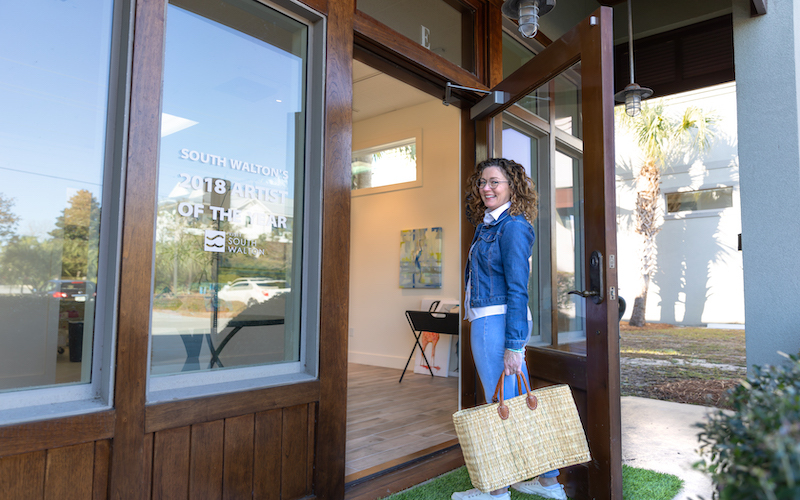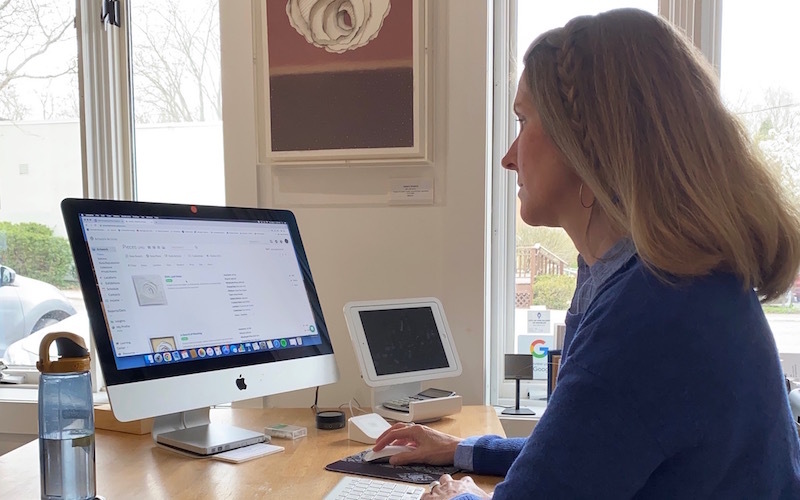 Artist, Kathleen Broaderick entering the studio.
Artist, Kathleen Broaderick entering the studio.
January is a great time to take stock of where you are in your career and make goals for the year ahead.
Artwork Archive is here to help you get organized and stay on track with the Schedule feature and the annual Guide to Best Artist Grants and Opportunities.
When setting goals, it’s important to be both realistic and ambitious.
What can you reasonably accomplish in a year and what would be a stretch for you as an artist?
A good baseline goal will vary from person to person depending on the time you have to spend on your art career in 2024. Additionally, when writing down your goals be as specific as possible. Instead of writing down that you will apply to five residencies, use some of your studio time in January to research and write down the deadlines of five residencies to which you want to apply. Then, make note of the specific requirements.
How to Approach Goal Setting for Part-Time Artists
If you’re spending less than 10 hours a week pursuing your art, you’re considered a hobby practitioner by the US government. Your goals will be about balancing your career aspirations with your time commitments.
Considering that you're likely dedicating time to other jobs to make a living, setting 10-12 career-related goals (roughly one per month) is feasible. One helpful tip is to break up the goals into categories. You could apply to 12 opportunities for the entire year or distribute the 12 goals, with 7 opportunities and 5 one-time tasks. These one-time tasks could include activities like cleaning your studio, participating in a local craft fair, documenting your work, attending a residency, and acquiring a new skill related to your practice.
To avoid feeling overwhelmed, it's advisable to keep your career goals separate from any personal goals you may have for 2024, such as running a marathon.
Adjusting Goals and Applications for Artists Working 15-20 Weekly Hours
If you’re spending 15-20 hours a week working as an artist, you should increase your goals or opportunity applications to 15-18 for the year—or one goal for every 50 hours of dedicated practice time. Of these, it would be wise to include both opportunity applications and one-time tasks that might take longer to accomplish.
Let your focus be quality over quantity with your applications.
If you decide to apply to 10 opportunities, select those that are well suited to your practice and lavish the necessary time to put together a competitive application. Include at least one task you find somewhat odious such as updating your website and create an early year deadline such as March 1st so you can feel the relief of knocking it off your to-do list.
Setting Ambitious Goals for Artists with Over 20 Weekly Hours
If you spend upwards of 20 hours a week working as an artist, you should consider applying for or working towards 30 or more applications or one-time career tasks in 2024.
You can include tasks that support your mental health or physical well-being because those kinds of goals help you sustain your full-time studio work. Examples of goals that make sense for people who work more than part-time on their art career might include: preparing an exhibition catalog to accompany a solo show, applying for an ambitious grant or fellowship such as a Pollock-Krasner, and taking 50 yoga classes at a local studio (roughly one a week).
Taking time this month to craft your road map for the year takes the guesswork out of meeting your goals. If you can, schedule weekly or monthly check-ins with a friend to create some outer accountability in addition to the reminders you can send yourself through Artwork Archive.
 Krista Reuter working on Artwork Archive, copyright Krista Reuter Studio.
Krista Reuter working on Artwork Archive, copyright Krista Reuter Studio.
Avoid Burnout by Tackling Administrative Tasks Effectively
You are ambitious and you have ambitious goals.
But, being a full-time artist doesn't have to completely take over your life—it's essential to find a balance. Many of us have pushed ourselves with 12+ hour workdays to achieve goals, but this isn't sustainable. Declining social invitations for work or ignoring your physical health can put a strain on your overall wellbeing.
Being a creative entrepreneur involves wearing many hats—bookkeeping, marketing, admin tasks, shipping, archiving, and, of course, creating. This workload can make it challenging to feel creative at the end of the day. However, the goal is to run your art business, not let it run you.
The common issue isn't having too much work but how we approach and allocate time to tasks. Many artists spend excessive hours on administrative aspects, leading to burnout before even stepping into the studio.
By clearly defining goals and the necessary steps, you save both time and mental energy. Artwork Archive is an online platform for artists to get organized, catalog their work and manage their workflow. With a free 14-day trial, you can see how artists use the platform to organize their inventory, showcase artwork, and effortlessly generate professional documents.
A well-organized system is the key to achieving your goals, and you can give it a try for free here.
Fill out the worksheets below to clarify the goals you have for yourself and for your art career.
Print out the following worksheets to develop SMART goals, set quarterly goals and big intentions, and map out the actionable steps needed to achieve your vision.
You can start setting goals by downloading Artwork Archive's free goal setting worksheets here. And, learn more about how to get started with Artwork Archive's free 14-day trial below.






bb22.png?1697647955)
